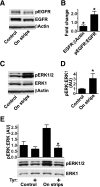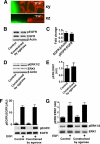Free edges in epithelial cell sheets stimulate epidermal growth factor receptor signaling
- PMID: 20462956
- PMCID: PMC2893982
- DOI: 10.1091/mbc.e09-12-1026
Free edges in epithelial cell sheets stimulate epidermal growth factor receptor signaling
Abstract
The ability of epithelia to migrate and cover wounds is essential to maintaining their functions as physical barriers. Wounding induces many cues that may affect the transition to motility, including the immediate mechanical perturbation, release of material from broken cells, new interactions with adjacent extracellular matrix, and breakdown of physical separation of ligands from their receptors. Depending on the exact nature of wounds, some cues may be present only transiently or insignificantly. In many epithelia, activation of the epidermal growth factor receptor (EGFR) is a central event in induction of motility, and we find that its continuous activation is required for progression of healing of wounds in sheets of corneal epithelial cells. Here, we examine the hypothesis that edges, which are universally and continuously present in wounds, are a cue. Using a novel culture model we find that their presence is sufficient to cause activation of the EGFR and increased motility of cells in the absence of other cues. Edges that are bordered by agarose do not induce activation of the EGFR, indicating that activation is not due to loss of any specific type of cell-cell interaction but rather due to loss of physical constraints.
Figures








Similar articles
-
Free edges in epithelia as cues for motility.Cell Adh Migr. 2011 Mar-Apr;5(2):106-10. doi: 10.4161/cam.5.2.13728. Epub 2011 Mar 1. Cell Adh Migr. 2011. PMID: 20953155 Free PMC article.
-
Wounding induces motility in sheets of corneal epithelial cells through loss of spatial constraints: role of heparin-binding epidermal growth factor-like growth factor signaling.J Biol Chem. 2004 Jun 4;279(23):24307-12. doi: 10.1074/jbc.M401058200. Epub 2004 Mar 23. J Biol Chem. 2004. PMID: 15039441
-
Wounding sheets of epithelial cells activates the epidermal growth factor receptor through distinct short- and long-range mechanisms.Mol Biol Cell. 2008 Nov;19(11):4909-17. doi: 10.1091/mbc.e08-01-0097. Epub 2008 Sep 17. Mol Biol Cell. 2008. PMID: 18799627 Free PMC article.
-
Hepatocyte growth factor induces epithelial cell motility through transactivation of the epidermal growth factor receptor.Exp Cell Res. 2007 Sep 10;313(15):3319-25. doi: 10.1016/j.yexcr.2007.06.006. Epub 2007 Jun 27. Exp Cell Res. 2007. PMID: 17643426 Free PMC article.
-
EGF receptor.Int J Biochem Cell Biol. 1999 Jun;31(6):637-43. doi: 10.1016/s1357-2725(99)00015-1. Int J Biochem Cell Biol. 1999. PMID: 10404636 Review.
Cited by
-
Junctional epithelium and hemidesmosomes: Tape and rivets for solving the "percutaneous device dilemma" in dental and other permanent implants.Bioact Mater. 2022 Mar 19;18:178-198. doi: 10.1016/j.bioactmat.2022.03.019. eCollection 2022 Dec. Bioact Mater. 2022. PMID: 35387164 Free PMC article. Review.
-
Extracellular ATP stimulates epithelial cell motility through Pyk2-mediated activation of the EGF receptor.Cell Signal. 2011 Dec;23(12):2051-5. doi: 10.1016/j.cellsig.2011.07.021. Epub 2011 Aug 4. Cell Signal. 2011. PMID: 21840393 Free PMC article.
-
A short peptide potentially promotes the healing of skin wound.Biosci Rep. 2019 Mar 22;39(3):BSR20181734. doi: 10.1042/BSR20181734. Print 2019 Mar 29. Biosci Rep. 2019. PMID: 30842341 Free PMC article.
-
Mechanisms of epithelial wound detection.Trends Cell Biol. 2015 Jul;25(7):398-407. doi: 10.1016/j.tcb.2015.02.007. Epub 2015 Mar 24. Trends Cell Biol. 2015. PMID: 25813429 Free PMC article. Review.
-
Royal jelly-derived proteins enhance proliferation and migration of human epidermal keratinocytes in an in vitro scratch wound model.BMC Complement Altern Med. 2019 Jul 12;19(1):175. doi: 10.1186/s12906-019-2592-7. BMC Complement Altern Med. 2019. PMID: 31299973 Free PMC article.
References
-
- Abercrombie M. Contact inhibition and malignancy. Nature. 1979;281:259–262. - PubMed
-
- Bindschadler M., McGrath J. L. Sheet migration by wounded monolayers as an emergent property of single-cell dynamics. J. Cell Sci. 2007;120:876–884. - PubMed
-
- Bjorklund M., Koivunen E. Gelatinase-mediated migration and invasion of cancer cells. Biochim. Biophys. Acta. 2005;1755:37–69. - PubMed
-
- Block E. R., Matela A. R., SundarRaj N., Iszkula E. R., Klarlund J. K. Wounding induces motility in sheets of corneal epithelial cells through loss of spatial constraints: role of heparin-binding epidermal growth factor-like growth factor signaling. J. Biol. Chem. 2004;279:24307–24312. - PubMed
Publication types
MeSH terms
Substances
Grants and funding
LinkOut - more resources
Full Text Sources
Research Materials
Miscellaneous

